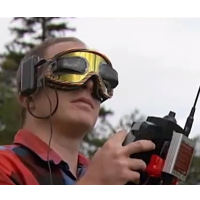Federal Government Clashes with Commercial Drone Industry
 Raphael Pirker at work
Raphael Pirker at work
The age-old struggle between private profit and public safety is now being waged in the skies, between the growing commercial drone industry and the Federal Aviation Administration (FAA), which recently took legal action for the first time against a drone pilot, fining him $10,000 for illegally operating a drone for commercial purposes and flying it “in a careless or reckless manner so as to endanger the life or property of another.”
The drone operator, Raphael Pirker, got into trouble over a video he made from a drone flying over the University of Virginia, with the citation alleging that the video records a series of aviation violations, including flying too low over vehicles, buildings, people, streets and structures, and even aiming the craft at a person, who Pirker says was his spotter.
Pirker is fighting the citation before the National Transportation Safety Board, arguing that the FAA lacks the authority to regulate drones and that its 2007 ban on commercial drone use is invalid because the agency did not hold public hearings on the rule, which Pirker contends were required by the Administrative Procedures Act (APA). The APA is supposed to ensure that federal agencies issue regulations in an open and transparent manner, but whether it requires a specific procedure such as a public hearing is often far from obvious.
If successful, the net effect of Pirker’s argument would be, in the words of his attorney Brendan Schulman, that “there is no enforceable federal regulation concerning the operation of” drones.
That anarchic scenario alarms air safety experts, as well as advocates of personal privacy. Like aviation authorities in Europe and Australia, the FAA is developing regulations for the commercial drone industry, but the rules won’t be ready until at least 2015. The agency will also gather data to support the drafting of the new rules by selecting six drone test ranges—as required by a 2012 law—that will “develop a body of data and operational experiences to inform integration and the safe operation” of commercial drones.
In the interim, drones will continue to be used in limited numbers for non-commercial purposes like firefighting, disaster relief, search and rescue, law enforcement, border patrol, military training, scientific research and environmental monitoring.
But business interests want the ban lifted immediately and for the FAA to write new rules in the meantime. In March, the Association for Unmanned Vehicle Systems International (AUVSI), an industry lobby that represents the interests of commercial drone owners, released a study claiming that “the main inhibitor of U.S. commercial and civil deployment of the UAS is the lack of a regulatory structure.” The report purports to show that the commercialization of drones would add 70,000 new jobs, including 34,000 manufacturing jobs, to the U.S. economy over the next three years and have an overall economic impact of $82.1 billion between 2015 and 2025.
Like all such claims that a particular policy will create thousands of jobs, the job numbers in the AUVSI report must be taken with a grain of salt. There is no guarantee that drone manufacturing would remain in the U.S., nor that growth would be as robust as the report, which does not account for jobs lost in competing sectors, imagines.
As for Mr. Pirker, even if his argument that the FAA violated the APA succeeds, he may be disappointed in the outcome of his case. Just as in 2011, when a federal appeals court ruled that the Department of Homeland Security broke the APA when it decided in 2009 to use “nude” body scanners as the “primary” security apparatus at airports, but allowed the TSA to continue using the scanners anyway because public safety was at stake, Pirker could find his argument validated, but the rule permitted to remain in place until the FAA can write a new one.
-Matt Bewig
To Learn More:
Drone Pilot Fights for Right to Profit in the Unmanned Skies (by David Kravets, Wired)
The Economic Impact of Unmanned Aircraft Systems Integration in the United States (by Darryl Jenkins and Dr. Bijan Vasigh, Association for Unmanned Vehicle Systems International) (pdf)
Finding Their Place: Governments and the Aviation Industry are Finding Ways to Incorporate Unmanned Aircraft into Shared Airspace (by Linda Werfelman, AeroSafety World)
Senate Explores Private and Law Enforcement Use of Drones in U.S. (by Noel Brinkerhoff, AllGov)
- Top Stories
- Unusual News
- Where is the Money Going?
- Controversies
- U.S. and the World
- Appointments and Resignations
- Latest News
- Musk and Trump Fire Members of Congress
- Trump Calls for Violent Street Demonstrations Against Himself
- Trump Changes Name of Republican Party
- The 2024 Election By the Numbers
- Bashar al-Assad—The Fall of a Rabid AntiSemite






Comments